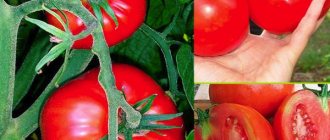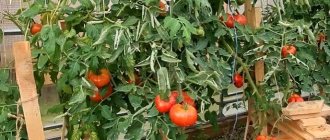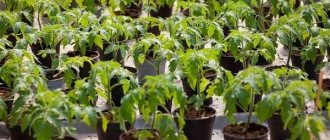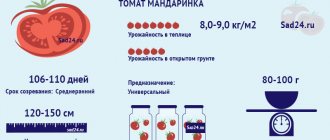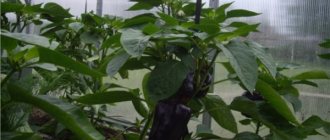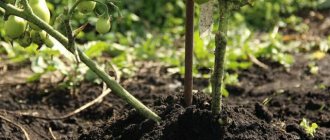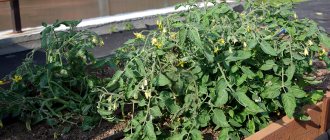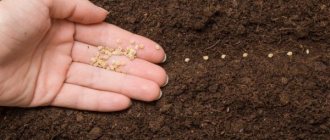Already from the name it is clear where the Lord of the Steppes F1 tomato likes to grow. It grows well in open beds and in greenhouse conditions. Recommended for cultivation throughout Russia - in the northern regions under a film, in warmer regions - without shelter.
| Height | Landing location | Ripening time | Fruit color | Fruit size | Origin | Fruit shape |
| short | Greenhouse, Open ground | Mid-season | Reds | Average | Hybrid | Round |
Description and characteristics of the variety
Lord of the Steppes F1 is a low-growing determinate hybrid. The height of the bushes does not exceed 50 cm. The shoots, despite their low growth, are powerful and spreading. They require garters and shaping.
Ripening time is average - 110-115 days from germination.
Tomatoes have a round shape and a rich red color. The taste harmoniously combines sourness and sweetness. Tomatoes are used universally:
- for fresh salads;
- whole into canning jars;
- for pickling and drying;
- in juices and pastes.
The average weight varies between 80-130 g, large specimens grow up to 160 g.
Advantages and disadvantages of the variety
Tomatoes of the Lord of the Steppes variety have important advantages:
- the variety exhibits optimal resistance to temperature fluctuations, heat and drought, so even in unfavorable weather conditions the chances of obtaining a good harvest increase;
- tomatoes are ideal for making winter pickles in cans;
- average resistance to diseases and parasites, therefore, in many situations, correct agricultural technology increases the chances of successfully obtaining the desired harvest;
- possibility of obtaining large fruits;
- optimal yield indicators;
- long-term storage (at least a month);
- resistance to transportation even over long distances.
For Russian gardeners, tomatoes of the Lord of the Steppes variety are among the best, but compliance with the basic principles of agricultural technology plays a very important role.
Rules for growing the variety
It is advisable to prepare seed material in a timely manner. Cultivation occurs by planting seeds in the ground. Planting seed material into the ground is recommended 60-65 days in advance. Picking is carried out when 1-2 true leaves appear, and this procedure increases the chances of obtaining the desired harvest and eliminating the risk of excessive development of green mass.
When transplanting seedlings, up to 5 plants are allowed per square meter.
This is due to the small size of tomato bushes. Note! The Lord of the Steppes variety does not need to be tied up, but the presence of support will not interfere with the plant.
Tying is no longer necessary, since tomato bushes are low-growing. Tying is advisable, as sometimes large fruits grow. Stepping is mandatory. The best harvest can be obtained when 2 main stems are formed. For the Lord of the Steppes variety, it is recommended to leave no more than 4 stems. It is important to note that the second stem is always formed from the stepson, which is located under the first brush. All other stepsons require timely removal to obtain a good harvest, and they need to be removed in a small amount to prevent stress in the tomatoes.
The first ripe tomatoes can be harvested approximately 105 days after the plant was planted in the ground.
Regular watering and loosening of the soil are mandatory for the Lord of the Steppes variety. They increase the chances of receiving the right amount of water and oxygen, so the tomatoes develop successfully.
During the season, it is advisable to carry out 3 feedings. In this case, the first application of fertilizers is recommended during the growing season, the second - when inflorescences appear, the third - at any time when growing tomatoes to improve the yield.
No special care required. Gardeners note that the Lord of the Steppes tomato variety requires standard agricultural technology.
Gazpacho
Mid-season low determinate tomato variety (the bush grows no higher than 40 cm). In the middle zone it is suitable for growing in greenhouses and open ground. The ripening period is about 117-125 days. Sowing for seedlings - in March-April. Picking seedlings - in the phase of the first true leaf. Planting in the ground - in May at the age of 40 days. Planting pattern – 40×60 cm.
The fruits are elongated, weighing about 80 g, and have a universal purpose. The yield is up to 4.7 kg per bush. The plant is resistant to nematode, verticillium and fusarium wilt.
Verlioka plus F1
Mid-early determinate tomato hybrid. In the middle zone it is suitable for growing in greenhouses and open ground. The ripening period is about 105 days. Sowing for seedlings - in late March - early April. Picking seedlings - in the phase of the first true leaf. Planting in the ground - in early to mid-May at the age of 40 days. Planting pattern – 40×60 cm.
The fruits are round in shape, weighing about 120-140 g, and have a universal purpose. The yield is 4.5-5 kg per bush. The plant is resistant to tobacco mosaic virus, fusarium and cladosporiosis.
Kubanets F1
Mid-early determinate tomato hybrid with short internodes. In the middle zone it is suitable for growing in greenhouses and open ground. The ripening period is about 100-105 days. Sowing for seedlings - March. Picking seedlings - in the phase of the first true leaf. Planting in the ground - in early to mid-May at the age of 45 days. Planting pattern – 40×60 cm.
Oval-shaped fruits, weighing 100-140 g, universal purpose. The yield is about 4 kg per bush. The plant is resistant to tomato mosaic virus, verticillium, fusarium, blossom end rot and bacterial spot.
Reviews
Vlada:
“I’ve been gardening for several years now. During this time, I tried different varieties of tomatoes. Last summer I grew Lord of the Steppes. Easy standard care allowed me to get a rich and very tasty harvest, so I immediately ranked the variety among my favorites. I also plan to plant Lord of the Steppes in the upcoming gardening season.”
Antonina:
“Vegetable gardening is my hobby. I love growing tasty and healthy vegetables, knowing that my efforts and time investment are completely worth it. The Lord of the Steppes variety of tomatoes is considered one of the best and tastiest, so I mainly choose it.”
Oksana:
“The Lord of the Steppes is a very famous and worthy variety of tomatoes. These are the tomatoes that can please beginners and experienced gardeners. In addition, agricultural technology is carried out according to a standard scheme and requires a minimum of time for gardeners.”
Characteristics and description of the tomato “Lord of the Steppes”
The Lord of the Steppes tomato belongs to the category of mid-season plants, the fruits of which at the stage of full biological maturation are medium in size and have a rich red color of the peel and pulp.
The demand for the hybrid among experienced gardeners is also due to the ability of the bushes to form the ovaries of future fruits under unfavorable weather conditions. The crop can be grown both in protected greenhouse conditions and in open ground.
Characteristics of the variety
Tomatoes have a well-balanced taste and large size. Bushes from seedlings, as a rule, grow to 55–60 cm. Optimal formation of a bush requires the presence of 3–4 main stems. The remaining shoots are subject to pinching. Despite the low growth of the bushes, they need careful tying to additional support due to the high yield of the bushes themselves. Indeed, from each plant you can collect about 6 - 6.5 kg of a full harvest.
The fruits have a round shape and an average weight of about 90 - 140 g. If you carefully follow the basic care requirements, you can count on fruits up to 160 - 180 g. Grown tomatoes can be used not only fresh, but also for preparing juices and sauces, hot dishes, as the main ingredient for canning for the winter.
Advantages and disadvantages
The list of positive properties of the hybrid includes:
- good resistance of bushes to long-term lack of watering and high air temperatures;
- patience with possible cold snaps and general variability of weather conditions;
- increased content of useful microelements and vitamins in the product;
- good shelf life and resistance to mechanical stress allows you to grow crops for further sale;
- the presence of bush resistance against possible fungal infections and other types of diseases.
It should be borne in mind that tomato bushes are very susceptible to insufficient sunlight, which is why you should choose completely open, unshaded areas of soil. The second important point concerns the protection of the site from strong gusty winds, as well as from cold drafts. If plants are planted in open ground, then for the first 1 - 1.5 weeks it is recommended to hide them under a temporary film cover. This will allow the roots to get used to it better and settle down faster, and the plants themselves will be protected from the possible return of spring night frosts.
Features of cultivation
Seed preparation should be done in advance. They can be treated with a light pink solution of potassium permanganate to increase the resistance of seedlings to various fungal diseases present in the soil. To germinate seeds, it is recommended to place them between layers of damp, clean natural fabric 1.5 - 2 weeks before sowing. Further moistening is carried out using a spray bottle. Already on the 3rd - 4th day, the seeds should swell well, and the first sprouts should emerge from the inside.
When planting sprouted seeds in the ground, it is extremely important not to break off the sprouts that have already appeared. The depth of the holes should be no more than 1 - 1.5 cm. The distance between the holes should be 2 - 3 cm. The first picking is allowed only after at least 2 - 3 full leaves have been formed on the stems. When moving mature seedlings to permanent soil, no more than 4 to 5 plants should be planted per 1 sq.m of area.
Mandatory care requirements include watering, removing weeds, loosening the soil, as well as fertilizing the soil three or four times with mineral or organic complexes. There should be at least a 2.5 - 3 week break between fertilizer uses.
Pests and diseases
The hybrid bushes are characterized by increased resistance to Fusarium lesions and Verticillium wilt. Possible diseases of mosaic viruses, which appear as brown spots on the leaves, stems and tomatoes themselves, are also not dangerous for tomatoes.
You may be interested in:
As a preventive protection against tobacco mosaic, spider mites and blossom end rot, which appear as brown spots, it is recommended to use a two-day infusion of garlic mixture. For this you need 250 - 300 g of pressed garlic and 8 - 9 liters of water. The first spraying should be carried out no earlier than two weeks after planting the seedlings, so that the root system has time to strengthen. Repeated treatment is carried out after a week's break.
Premature yellowing and curling of leaves on tomato bushes may indicate a lack of copper in the nutrient complex. It can be replenished by adding mineral complexes to the water, which is then used to water the tomatoes.
If fungicides are used to treat bushes against insect pests, it is better to spray in the late evening so that the substance has time to be absorbed into the leaves and not just evaporate. The work itself must be carried out no later than 2.5 - 3 weeks before the planned harvest.
Reviews
Alexandra Ivanovna, 49 years old
To minimize stress for plants during the process of picking root systems, seeds can be planted in separate small containers. At the same time, there must be several holes at the bottom, which will allow excess water not to stagnate in the soil and not provoke the manifestation of damage to the roots by blackleg or fusarium. If deciduous soil is used in preparing the soil, it is not recommended to collect it under coniferous trees, as well as under chestnuts and oak, due to its oversaturation with tannins, which interfere with the full growth and development of seedlings.
Oleg Ivanovich, 52 years old
It is important to grow tomato seedlings in healthy, fertilized soil. To get rid of any doubts about the quality of the soil, it can be disinfected in advance. To do this, use a boiling bright pink solution of potassium permanganate, which is poured into a container with soil. The top of the container must be covered with film or glass, which will provide an additional steaming effect. Seeds can be planted only after the soil has completely cooled.
To disinfect open soils, it is recommended to sow mustard or turnips densely even during autumn tillage. When the seeds sprout with the onset of the first full warmth, you just need to mow them and carefully dig up the soil. As practice shows, this trick reduces the risk of disease by 2–3 times.
sveklon.ru
Kalroma F1
Early ripening determinate hybrid of tomato. In the middle zone it is suitable for growing in greenhouses and open ground. The ripening period is about 90-100 days. Sowing for seedlings - March. Picking seedlings - in the phase of the first true leaf. Planting in the ground - in early to mid-May at the age of 45 days. Planting pattern – 40×60 cm.
The fruits are elongated, weighing 80-85 g, universal purpose. The yield is 4.5-5 kg per bush. The plant is resistant to fusarium, verticillium, bacterial spot and nematode. Withstands sudden temperature changes.
